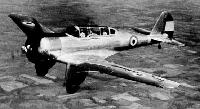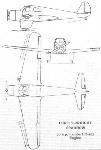
Curtiss-Wright CW-19 и CW-23
CW-19L Coupe, спроектированный Джорджем Пэйджем в 1935 году, представлял собой современный свободнонесущий цельнометаллический двухместный моноплан с низкорасположенным крылом, предназначавшимся для частного пользования. CW-19L со звездообразным двигателем Lambert R-266 мощностью 90 л.с. (67 кВт) во время испытаний показал, что он обладает хорошей маневренностью, но имеет недостаточную мощность силовой установки. В конструкции CW-19W сохранилась компоновка рядом расположенных кресел кабины, но вместо Lambert устанавливался звездообразный двигатель Warner Super Scarab мощностью 145 л.с. (108 кВт).
Военный CW-19R характеризовался радикально измененной конструкцией и предназначался на экспорт. Два члена экипажа располагались тандемно под длинным сдвижным фонарем, имелась возможность установки пулеметов и подвески легких бомб под крылом. На обтекатели шасси могли устанавливаться дополнительные пулеметы - в случае использования машины в качестве штурмовика.
Руководство "Curtiss-Wright" считало, что CW-19R удовлетворит потребность в истребителе общего назначения, разведчике и штурмовике. Но продажи оказались ограниченными - 20 самолетов закупил Китай, и три самолета приобрела Куба. Возможности машины значительно увеличились после установки мотора Whirlwind J-6-9 (R-975E) мощностью 450 л.с. (336 кВт), она стала демонстрировать хорошие летные характеристики и превосходную скороподъемность.
Невооруженный вариант CW-19R для базовой подготовки летчиков выпускался под обозначением CW-A19R. С февраля 1937 года его оценивал авиакорпус Армии США, но заказов не поступило. Было построено три таких самолета, один позднее переоборудовали в CW-22. На базе CW-19R создали единственный CW-23, он оснащался звездообразным двигателем Pratt & Whitney R-1340 Wasp мощностью 600 л.с. (447 кВт) и убирающимся внутрь фюзеляжа основным шасси, и рассматривался в качестве основного учебно-боевого самолета для авиакорпуса Армии США. Самолет поднялся в воздух в 1939 году, но после оценочных испытаний заказчик от него отказался.
Вариант
CW-B19R: нереализованный проект гражданского варианта CW-A19R
ТАКТИКО-ТЕХНИЧЕСКИЕ ХАРАКТЕРИСТИКИ
Curtiss-Wright CW-19R
Тип: двухместный легкий истребитель и штурмовик
Силовая установка: один звездообразный ПД Wright R-760E2 Whirlwind мощностью 350 л.с. (261 кВт)
Летные характеристики: максимальная скорость 298 км/ч на оптимальной высоте; крейсерская скорость 264 км/ч на оптимальной высоте; начальная скороподъемность 576 м/мин
Масса: пустого 904 кг; максимальная взлетная 1588 кг
Размеры: размах крыла 10,67 м; длина 8,03 м; высота 2,49 м; площадь крыла 16,16м2
Вооружение: фиксированный 7,62-мм пулемет в верхней передней части фюзеляжа и один наводимый 7,62-мм пулемет в задней кабине для обороны задней полусферы, плюс возможность установки дух неподвижных 7,62-мм пулеметов для стрельбы вперед на внешних сторонах обтекателей основных стоек шасси, а также малокалиберные авиабомбы на подкрыльевых держателях
Описание:
- Curtiss-Wright CW-19 и CW-23
- Flight, October 1935
TEMPTING the U.S. PRIVATE OWNER
Фотографии
-
Jane's All the World Aircraft 1938 / 03 - All the world's aeroplanes
The Curtiss-Wright 19R Two-seat Military Monoplane (450 h.p. Wright "Whirlwind" engine).
-
Flight 1935-10 / Flight
IS CURTISS RIGHT? This, the new Curtiss-Wright Sparrow is that company's idea of an aeroplane for the masses. No one will deny that it has numerous attractive features - side-by-side seats, a creditable performance and good speed range. The fixed slots may be seen to advantage in this photograph.
-
Flight 1935-10 / Flight
Two outstanding features from the aerodynamic standpoint are the fixed slots and the ailerons, which are locked against downward travel past the neutral position.
-
Jane's All the World Aircraft 1938 / 03 - All the world's aeroplanes
Регистрационный номер: NR11781 The Curtiss-Wright A-19R Training Monoplane (420 h.p. Wright "Whirlwind" engine).
-
Мировая Авиация 99
Общей чертой для всех самолетов серии CW-19 были характерные обтекатели на основных стойках шасси и неубирающееся хвостовое колесо.
-
Flight 1935-10 / Flight
Engine inspection is facilitated by this collapsible N.A.C.A. cowling which is hinged at the top.
-
Flight 1935-10 / Flight
Curtiss-Wright Sparrow 90 h.p. Lambert R-266 Engine
- Фотографии






